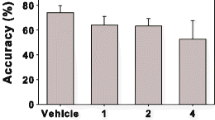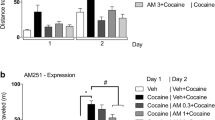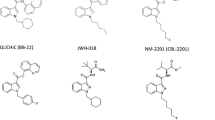Abstract
Rationale
In human beings and experimental animals, maladaptive impulsivity is manifested by the acute injection of psychostimulants, such as amphetamine. Cannabinoid CB1 receptors have been implicated in the regulation of stimulant-induced impulsive action, but the role of CB1 receptors in timing-related impulsive action by amphetamine remains unknown.
Methods
Male rats were used in evaluating the effects of CB1 receptor antagonist and agonist (SR141716A and WIN55,212–2, respectively) systemically administered individually and combined with d-amphetamine on a differential reinforcement of low-rate response (DRL) task, an operant behavioral test of timing and behavioral inhibition characterized as a type of timing impulsive action.
Results
A distinct pattern of DRL behavioral changes was produced by acute d-amphetamine (0, 0.5, 1.0, and 1.5 mg/kg) treatment in a dose-dependent fashion, whereas no significant dose effect was detected for acute SR141716A (0, 0.3, 1, and 3 mg/kg) or WIN55,212–2 (0, 0.5, 1, and 2 mg/kg) treatment. Furthermore, DRL behavior altered by 1.5 mg/kg d-amphetamine was reversed by a noneffective dose of SR141716A (3 mg/kg) pretreatment. The minimally influenced DRL behavior by 0.5 mg/kg d-amphetamine was affected by pretreatment with a noneffective dose of WIN55,212–2 (1 mg/kg).
Conclusion
These findings reveal that the activation and blockade of CB1 receptors can differentially modulate the timing impulsive action of DRL behavior induced by acute amphetamine treatment. Characterizing how CB1 receptors modulate impulsive behavior will deepen our understanding of the cannabinoid psychopharmacology of impulsivity and may be helpful in developing an optimal pharmacotherapy for reducing maladaptive impulsivity in patients with some psychiatric disorders.





Similar content being viewed by others
References
Abraham AD, Fontaine HM, Song AJ, Andrews MM, Baird MA, Kieffer BL, Land BB, Chavkin C (2018) κ–opioid receptor activation in dopamine neurons disrupts behavioral inhibition. Neuropsychopharmacology 43:362–372
Ashok AH, Mizuno Y, Volkow ND, Howes OD (2017) Association of stimulant use with dopaminergic alterations in users of cocaine, amphetamine, or methamphetamine: a systematic review and meta-analysis. JAMA Psychiat 74:511–519
Cheng R-K, Liao R-M (2007) Dopamine receptor antagonists reverse amphetamine-induced behavioral alteration on a differential reinforcement for low-rate (DRL) operant task in the rat. Chin J Physiol 50:77–88
Cheng R-K, Liao R-M (2017) Regional differences in dopamine receptor blockade affect timing impulsivity that is altered by d-amphetamine on differential reinforcement of low-rate responding (DRL) behavior in rats. Behav Brain Res 331:177–187
Cheng R-K, Liao R-M (2020) Examination of the effects of SCH23390 and raclopride infused in the dorsal striatum on amphetamine-induced timing impulsivity measured on a differential reinforcement of low-rate responding (DRL) task in rats. Behav Brain Res 379:112364
Cheng RK, MacDonald CJ, Meck WH (2006) Differential effects of cocaine and ketamine on time estimation: implications for neurobiological models of interval timing. Pharmacol Biochem Behav 85:114–122
Cheng RK, MacDonald CJ, Williams CL, Meck WH (2008) Prenatal choline supplementation alters the timing, emotion, and memory performance (TEMP) of adult male and female rats as indexed by differential reinforcement of low-rate schedule behavior. Learn Mem 15:153–163
Chiang F-K, Cheng R-K, Liao R-M (2015) Differential effects of dopamine receptor subtype-specific agonists with respect to operant behavior maintained on a differential reinforcement of low-rate responding (DRL) schedule. Pharmacol Biochem Behav 130:67–76
Chuang C-Y, Tsai S-Y, Chen S-F, Yang Y-H, Chao C-C, Yen N-S, Liao R-M (2021) Neurobiological changes in striatal glutamate are associated with trait impulsivity of differential reinforcement of low-rate-response behavior in male rats. Neurobiol Learn Mem 177:107352
Click SD, Cox RD, Greenstein S (1975) Relationship of rats’ spatial preference to effects of d-amphetamine on timing behavior. Eur J Pharmacol 33:173–182
Covey DP, Mateo Y, Sulzer D, Cheer JF, Lovinger DM (2017) Endocannabinoid modulation of dopamine neurotransmission. Neuropharmacology 124:52–61
Dalley JW, Everitt BJ, Robbins TW (2011) Impulsivity, compulsivity, and top-down cognitive control. Neuron 69:680–694
Dalley JW, Mar AC, Economidou D, Robbins TW (2008) Neurobehavioral mechanisms of impulsivity: fronto-striatal systems and functional neurochemistry. Phramacol Biochem Behav 90:250–260
Dalley JW, Robbins TW (2017) Fractionating impulsivity: neuropsychiatric implication. Nat Rev Neurosci 18:158–171
Dalley JW, Roiser JP (2012) Dopamine, serotonin and impulsivity. Neuroscience 215:42–58
D’Amour-Horvat V, Leyton M (2014) Impulsive actions and choices in laboratory animals and humans: effect of high vs. low dopamine states produced by systemic treatments given to neurologically intact subjects. Front Behav Neurosci 8:432. https://doi.org/10.3389/fnbeh.2014.00432
Drews E, Schneider M, Koch M (2005) Effects of the cannabinoid receptor agonist WIN 55,212–2 on operant behavior and locomotor activity in rats. Pharmacol Biochem Behav 80:145–150
Eagle DM, Baunez C (2010) Is there an inhibitory-response-control system in the rat? Evidence from anatomical and pharmacological studies of behavioral inhibition. Neurosci Biobehav Rev 34:50–72
Engeln M, Ansquer S, Dugast E, Bezard E, Belin D, Fernagut P-O (2016) Multi-facetted impulsivity following nigral degeneration and dopamine replacement therapy. Neuropharmacology 109:69–77
Evenden JL (1999a) Varieties of impulsivity. Psychopharmacology 146:348–361
Evenden JL (1999b) Impulsivity: a discussion of clinical and experimental findings. J Psychopharmacol 13:180–192
Ferland J-MN, Carr MR, Lee AM, Hoogeland ME, Winstanley CA, Pattij T (2018) Examination of the effects of cannabinoid ligands on decision making in a rat gambling task. Pharmacol Biochem Behav 170:87–97
Fowler SC, Pinkston J, Vorontsova E (2009) Timing and space usage are disrupted by amphetamine in rats maintained on DRL 24-s and DRL 72-s schedules of reinforcement. Psychopharmacology 204:213–225
Gabriel DBK, Freels TG, Setlow B, Simon NW (2019) Risky decision-making is associated with impulsive action and sensitivity to first-time nicotine exposure. Behav Brain Res 359:579–588
Gallo A, Bouchard C, Rompre P-P (2014) Animals with schizophrenia-like phenotype are differentially sensitive to the motivational effects of cannabinoid agonists in conditioned place preference. Behav Brain Res 268:202–212
Gardner EL (2005) Endocannabinoid signaling systems and brain reward: emphasis on dopamine. Pharmacol Biochem Behav 81:263–284
Grissom NM, Reyes TM (2019) Let’s call the whole thing off: evaluating gender and sex differences in executive function. Neuropsychopharmacology 44:1–11
Han CJ, Robinson JK (2001) Cannabinoid modulation of time estimation in the rat. Behav Neurosci 115:243–246
Hankosky ER, Gulley JM (2013) Performance on an impulse control task is altered in adult rats exposed to amphetamine during adolescence. Develop Psychobiol 55:733–744
Hu SS, Mackie K (2015) Distribution of the endocannabinoid system in the central nervous system. Handb Exp Pharmacol 231:59–93
Huang Y-C, Wang S-J, Chiou L-C, Gean P-W (2003) Mediation of amphetamine-induced long-term depression of synaptic transmission by CB1 cannabinoid receptors in the rat amygdala. J Neurosc 23:10311–10320
Jarbe TUC, Andrzejewski ME, DiPatrizio NV (2002) Interactions between the CB1 receptor agonist Δ9-THC and the CB1 receptor antagonist SR-141716 in rats: Open-field revisited. Pharmacol Biochem Behav 73:911–919
Jarbe TUC, DiPatrizio NV, Chen L, Makriyannis A (2003) The cannabinoid receptor antagonist SR-141716 does not readily antagonize open-field effects induced by the cannabinoid receptor agonist (R)-methanandamide in rats. Pharmacol Biochem Behav 75:809–821
Jarbe TUC, Ross T, DiPatrizio NV, Pandarinathan L, Makriyannis A (2006) Effects of the CB1R agonist WIN-55,212–2 and the CB1R antagonists SR-141716 and AM-1387: Open-field examination in rats. Pharmacol Biochem Behav 85:243–252
Jentsch JD, Ashenhurst JR, Cervantes MC, Groman SM, James AS, Pennington ZT (2014) Dissecting impulsivity and its relationships to drug addictions. Ann N Y Acad Sci 1327:1–26
Liao R-M (2009) Effects of amphetamine and cocaine on behavior maintained by differential reinforcement of low-rate-response (DRL) schedule. Chin J Physiol 52:250–263
Liao R-M, Cheng R-K (2005) Acute effects of d-amphetamine on the DRL behavior in the rat: comparison with selective dopamine receptor antagonists. Chin J Physiol 48:41–50
Logan GD, Cowan WB (1984) On the ability to inhibit thought and action—a theory of an act of control. Psychol Rev 91:295–327
Lovic V, Palombo DJ, Fleming AS (2011) Impulsive rats are less maternal. Develop Psychobiol 53:13–22
Lynch CJ, Prus AJ (2021) Assessment of antidepressant-like effects of dextromethorphan on differential reinforcement of low-rate 72-s performance in rats. Behav Pharamcol 32:549–560
MacKillop J, Weafer J, Gray JC, Oshri A, Palmer A, de Wit H (2016) The latent structure of impulsivity: impulsive choice, impulsive action, and impulsive personality traits. Psychopharmacology 233:3361–3370
McAuley JD, Miller JP, Pang KCH (2006) Modeling the effects of the NMDA receptor antagonist MK-801 on timing in rats. Behav Neurosci 120:1163–1168
McClure GY, McMillan DE (1997) Effects of drugs on response duration differentiation: VI. Differential effects under differential reinforcement of low rates of responding schedules. J Pharmacol Exp Ther 281:1368–1380
McLaughlin PJ, Winston K, Swezey L, Wisniecki A, Aberman J, Tardif DJ, Betz AJ, Ishiwari K, Makriyannis A, Salamone JD (2003) The cannabinoid CB1 anatgonist SR 141716A and AM 251 suppress food intake and food-reinforced behavior in a variety of tasks in rats. Behav Pharmacol 14:583–588
Mitchell MR, Potenza MN (2015) Importance of sex differences in impulsive control and addictions. Front Psychiatry 6:24
Monterosso J, Ainslie G (1999) Beyond discounting: possible experimental models of impulse control. Psychopharmacology 146:339–347
Muschapmt JW, Siviy SM (2002) Behavioral sensitization to amphetamine follows chronic administration of the CB1 agonist WIN55,212–2 in Lewis rats. Pharmcol Biochem Behav 73:835–842
O’Donnell JM, Marek GJ, Seiden LS (2005) Antidepressant effects assessed using behavior maintained under a differential-reinforcement-of-low-rate (DRL) operant schedule. Neurosci Biobehav Rev 29:785–798
Parsons LH, Hurd YL (2015) Endocannabinoid signaling in reward and addiction. Nat Rev Neurosci 16:579–594
Pattij T, Janssen MCW, Schepers I, González-Cuevas G, de Vries TJ, Schoffelmeer ANM (2007) Effects of the cannabinoid CB1 receptor antagonist rimonabant on distinct measures of impulsive behavior in rats. Psychopharmacology 193:85–96
Pattij T, Vanderschuren LJMJ (2008) The neuropharmacology of impulsive behaviour. Trends Pharmacol Sci 29:192–199
Pattij T, Vanderschuren LJMJ (2020) The neuropharmacology of impulsive behaviour, an update. Curr Topics Behav Neurosci 47:3–22
Polissidis A, Chouliara O, Galanopoulos A, Marselos M, Papadopoulou-Daifoti Z, Antoniou K (2009) Behavioural and dopaminergic alterations induced by a low dose of WIN 55,212–2 in a conditioned place preference procedure. Life Sci 85:248–254
Polissidis A, Chouliara O, Galanopoulos A, Rentesi G, Dosim M, Hyphantis T, Marselos M, Papadopoulou-Daifoti Z, Nomikos GG, Spyraki C, Tzavara ET, Antoniou K (2010) Individual differences in the effects of cannabinoids on motor activity, dopaminergic activity and DARPP-32 phosphorylation in distinct regions of the brain. Intl J Neuropsychopharmcol 13:1175–1191
Polissidis A, Chouliara O, Galanopoulos A, Naxakis G, Papahatjis D, Papadopoulou-Daifoti Z, Antoniou K (2014) Cannabinoids negatively modulate striatal glutamate and dopamine release and behavioural output of acute d-amphetamine. Behav Brain Res 270:261–269
Robbins TW (2002) The 5-choice serial reaction time task: behavioural pharmacologyand functional neurochemistry. Psychopharmacology 163:362–380
Sanabria F, Killeen PR (2008) Evidence for impulsivity in the spontaneously hypertensive rat drawn from complementary response-withholding tasks. Behav Brain Funct 4:7. https://doi.org/10.1186/1744-9081-4-7
Sanger DJ, Blackman DE (1989) Operant behavior and the effects of centrally acting drugs. In: Boulton AA, Baker GB, Greenshaw AJ (eds) Neuromethods (vol. 13): Psychopharmacology. Humana Press, Clifton, pp 299–334
Simon NW, Beas BS, Montgomery KS, Haberman RP, Bizon JL, Setlow B (2013) Prefrontal cortical-striatal dopamine receptor mRNA expression predicts distinct form of impulsivity. Eur J Neurosci 37:1779–1788
Sulzer D, Sonders MS, Poulsen NW, Galli A (2005) Mechanisms of neurotransmitter release by amphetamines: a review. Prog Neuorbiol 75:406–433
Uslaner JM, Robinson TE (2006) Subthalamic nucleus lesions increase impulsive action and decrease impulsive choice - mediation by enhanced incentive motivation? Eur J Neurosci 24:2345–2354
van Haaren F (1993) Schedule-controlled behavior: positive reinforcement. In: Techniques in the behavioral and neural sciences (vol. 10): methods in behavioral pharmacology (van Haaren F, ed), pp81-99. Amsterdam: Elsevier
van Haaren F, Heinsbrock RPW, Louwerse A, van de Poll NE (1986) D-Amphetamine differentially affects low, but not high response rates of male and female Wistar rats. Psychopharmacology 89:73–76
van Hest A, van Haaren F, van de Poll NE (1987) Behavioral differences between male and female Wistar rats on DRL schedules: effect of stimuli promoting collateral activities. Physiol Behav 39:255–261
Velazquez-Sanchez C, Ferragud A, Moore CF, Everitt BJ, Sabino V, Cottone P (2014) High trait impulsivity predicts food addiction-like behavior in the rat. Neuropsychopharmacology 39:2463–2472
Weafer J, de Wit H (2014) Sex differences in impulsive action and impulsive choice. Addict Behav 39:1573–1579
Wiley JL, Compton AD, Golden KM (2000) Separation of drug effects on timing and behavioral inhibition by increased stimulus control. Exp Clin Psychopharmacol 8:451–461
Winstanley CA (2011) The utility of rat models of impulsivity in developing pharmacotherapies for impulse control disorders. Br J Pharmacol 164:1301–1321
Wiskerke J, Pattij T, Schoffelmeer ANM, De Vries TJ (2008) The role of CB1 receptors in psychostimulant addiction. Addict Biol 13:225–238
Wiskerke J, Stoop N, Schetters D, Schoffelmeer ANM, Pattij T (2011a) Cannabinoid CB1 receptor activation mediates the opposing effects of amphetamine on impulsive action and impulsive choice. PLoS ONE 6(10):e25856
Wiskerke J, Schetters D, van Es IE, van Mourik Y, den Hollander BRO, Schoffelmeer ANM, Pattij T (2011b) μ-opioid receptors in the nucleus accumbens shell region mediate the effects of amphetamine on inhibitory control but not impulsive choice. J Neurosci 31:262–272
Wiskerke J, van Mourik Y, Schetters D, Schoffelmeer ANM, Pattij T (2012) On the role of cannabinoid CB1- and μ-opioid receptors in motor impulsivity. Front Pharmacol 3:108
Acknowledgements
Authors are indebted to technical assistance provided by Y-C Wang, C-Y Wang, and S-Y Wu.
Funding
This study was supported in part by grants from the Ministry of Science and Technology, Taiwan (MOST 104–2410-H-004–047-MY3; MOST 107–2410-H-004–109-MY3; MOST 109–2420-H-004–021).
Author information
Authors and Affiliations
Contributions
Conceptualization: RML.
Experimental design: RML and SFC.
Behavioral experiment: SFC, WCH, XYL, and CYC.
Data reduction: SFC, WCH, and XYL.
Statistical analysis: SFC and RML.
Writing original draft: RML.
Manuscript editing and revision: SFC and RML.
Project administration: SFC and RML.
Funding acquisition: RML.
Corresponding author
Ethics declarations
Conflict of interest
The authors declare no competing interests.
Additional information
Publisher’s note
Springer Nature remains neutral with regard to jurisdictional claims in published maps and institutional affiliations.
This article belongs to a Special Issue on Cannabis and Cannabinoids
Rights and permissions
About this article
Cite this article
Chen, SF., Hsu, WC., Lu, XY. et al. Comparative effects of cannabinoid CB1 receptor agonist and antagonist on timing impulsivity induced by d-amphetamine in a differential reinforcement of low-rate response task in male rats. Psychopharmacology 239, 1459–1473 (2022). https://doi.org/10.1007/s00213-021-06018-z
Received:
Accepted:
Published:
Issue Date:
DOI: https://doi.org/10.1007/s00213-021-06018-z




